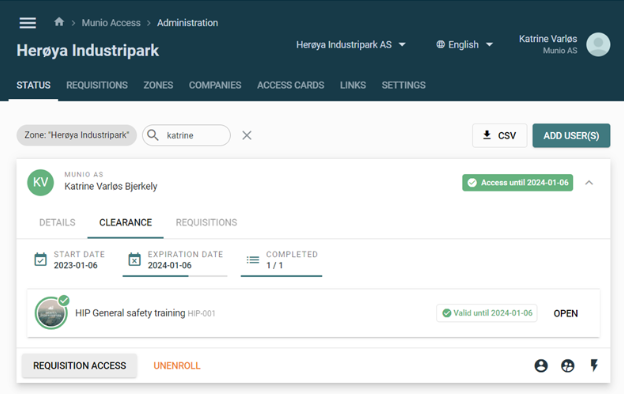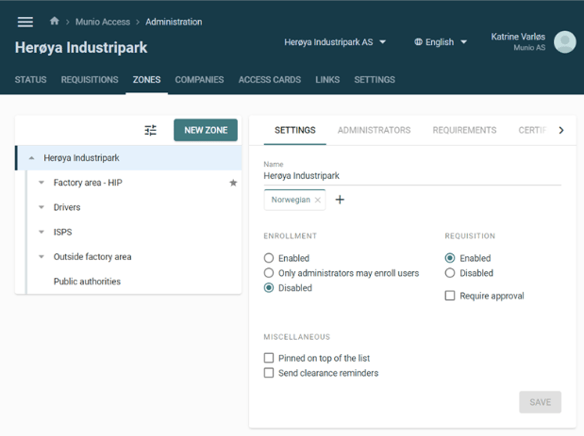When you bring employees or contractors onto a worksite, there is nothing more important than ensuring that they are safe while there.
Going through the risk assessment process means you can have controls put in place for a wide variety of scenarios –
- On a construction site you can have rigorous scaffolding checks and heavy machinery/plant management in place.
- On a factory floor you will probably have multiple fixed guards on any machinery, with a lockout/tag-out procedure.
- Control measures for road works would include detailed surveying and traffic management, and liaising with local authorities.
So much of making people safe happens before they have even set foot on site. You need to make sure that your workers have the relevant certifications, training and authorizations before they have access to potentially hazardous or sensitive work areas.
This can be tricky to manage. You might have hundreds of workers accessing the site, both your own employees and contractors. How can you ensure that all are compliant and successfully fulfil induction and orientation requirements?
You can achieve this through Access Control.
What is Access Control?
To put it simply, Access Control is a protective measure that controls or limits access to a workspace or asset. This can be achieved through a variety of methods.
Here is what you might typically envisage when considering the term ‘Access Control’:
- Barriers such as locks, gates, doors, or turnstiles.
- Entrances that are manned by security personnel.
- Personal access devices like pin codes, ID cards.
- Biometric identifiers like fingerprints or retinal scans.
Rapidly developing technology has led to access control becoming more sophisticated. For example, in a large tech company it’s unlikely that just anyone would be granted access to a server room. Permissions are therefore set up that allow only IT specialists entry, but no other employees.
Another example would be in a large chemical manufacturing plant. Workers involved in the distribution of the products are not going to require access to the factory floor and the potentially hazardous environments therein.
Access control also plays a vital role in reducing safety risks to employees, contractors and the public.
Access control and safety training
In a health and safety context, access control can be used to ensure that only workers with the correct credentials and relevant training have access to a specific work site.
Say you are the manager of a busy construction site. In the US construction deaths due to falls, slips, and trips increased 5.9 percent in 2021, and there will be pressure to ensure that all workers have the relevant safety training. To facilitate this, you have created a safety training programme and site onboarding that has to completed before they arrive onsite. Your business may also decide that the following voluntary certification is required:
You might have dozens of workers scheduled to come on site over the duration of the project, amongst them contractors from several different companies. Contractors in particular are unlikely to be familiar with the layout of the site. How will you manage the volume of people coming through and accompanying documentation?
Utilizing an access management system that integrates with your safety training system means that you can prevent access to the worksite to workers or contractors who do not meet your training requirements, or do not have valid documentation.
Simply put, the workers and contractors who fulfil all the requirements gain entry. Those who do not, remain off- site until they do.

A system such as this would also provide oversight as to when training is due to expire, meaning that you can always have a plan to refresh employee training.
Implementing access zones
Going back to a manufacturing plant example, this is case where implementing access zones can be hugely beneficial. A pharmaceutical plant would likely contain not only the manufacturing plant, but research laboratories, offices and external storage and warehouses. You will need to make sure that all employees have the appropriate access levels for their role.
If we take a closer look at the manufacturing plant itself, this could require multiple access zones due to the nature of the work being carried out. You may decide that all workers require training in HVACs and Cleanrooms. If there is an area where cell cultures are being propagated, training requirements might include Bioprocessing courses.
Setting up training requirements for different working zones in the same area decreases the chances of untrained workers engaging in potentially hazardous or destructive activities.

Conclusion
Employers in the US have legal obligations under the OSH Act 1970 to provide adequate safety training to their employees, and also must ensure that contractors onsite are compliant. Similar requirements can be found in Canadian provinces like Ontario under the Occupational Health and Safety Act (OHSA), and to workplaces under federal jurisdiction in Part II of the Canada Labour Code.
Access control gives your organization complete control over two vital areas: physical access to worksites and training compliance.
Managing access control and training requirements doesn’t have to be a source of stress. Discover Learn more about how EcoOnline’s Access software can simplify the entire process.
